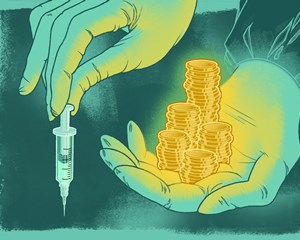So that's coronavirus and malaria on our list. What else might we be able to eradicate if we had $1tn to spend?
我們的名單上有冠狀病毒和瘧疾。如果我們有1萬億美元可以支出,那么我們還能根除什么呢?
Tuberculosis is a bacterial disease that kills almost 2 million people each year, overwhelmingly in poor and middle-income countries. The factor holding back eradication has not been a lack of understanding the biology of the disease, but a chronic lack of resources, and the growth of resistance of the pathogen to our bacterial treatments. We can change this. We can tackle other tropical diseases, too, such as schistosomiasis, a debilitating parasitic disease that affects 200 million people a year.
肺結核是一種細菌性疾病,每年導致近200萬人死亡,絕大多數發生在貧窮和中等收入國家。阻礙根除的因素并不是缺乏對這種疾病在生物學上的了解,而是資源的長期缺乏,以及病原體對細菌治療的耐藥性的增長。我們可以改變這一點。我們還可以對付其他的熱帶病,例如血吸蟲病,這是一種會使人身體衰弱的寄生蟲病,每年會對2億人產生影響。
But let's think bigger even than curing all infectious diseases. Picture a world free of all disease. Thousands of scientists and doctors are striving to treat and cure the world's biggest killers: cancer, cardiovascular disease and neurological disease. With an injection of cash, we could boost their chances, and see if we could transform the entire human experience by removing all illness. But if you want to make immense gains in public health on a global scale, and make them sustainable, there is one serious, ambitious, difficult, complex and expensive thing that needs to be implemented. This doesn't seem to be something that is talked about or invested in by billionaires: universal healthcare.
但是,讓我們想想比治愈所有傳染病更大的問題。想象一個沒有任何疾病的世界。成千上萬的科學家和醫生正在努力治療和治愈世界上最大的殺手:癌癥、心血管疾病和神經系統疾病。只要注入現金,我們就能提高他們的機會,看看能否通過消除所有疾病來改變人類的整個經歷。但是,如果你想在全球范圍內取得巨大的公共衛生成就,并使其可持續發展,有一件嚴肅的、野心勃勃的、困難的、復雜和昂貴的事情需要落實。全民醫保似乎不是億萬富翁們談論或投資的對象。

The World Bank published its first analysis of global health, the World Development report, in 1993. Targeted at government finance ministers, the report showed that health expenditure could improve prosperity as well as individual wellbeing. To mark the 20th anniversary of publication, an international Lancet commission put together an investment framework to achieve what they call a "grand convergence" in health by 2035.
世界銀行于1993年發布了其第一份全球衛生分析報告《世界發展報告》。這份針對政府財政部長的報告顯示,醫療支出可以改善富貴和個人福祉。為了紀念出版20周年,《柳葉刀》的一家國際委員會制定了一個投資框架,以在2035年前實現他們所謂的健康“大趨同”。
By this, they mean bringing deaths from infectious disease in low-and middle-income countries, as well as child and maternal deaths, to the levels seen in the best-performing middle-income countries: China, Chile, Costa Rica and Cuba. A grand convergence, the paper predicts, could prevent some 10 million deaths in 2035.
這意味著使低收入和中等收入國家的傳染病死亡人數,以及兒童和孕產婦死亡人數,達到表現最好的中等收入國家(中國、智利、哥斯達黎加和古巴)的水平。該論文預測,到2035年,一次大的趨同可以防止大約1000萬人死亡。











